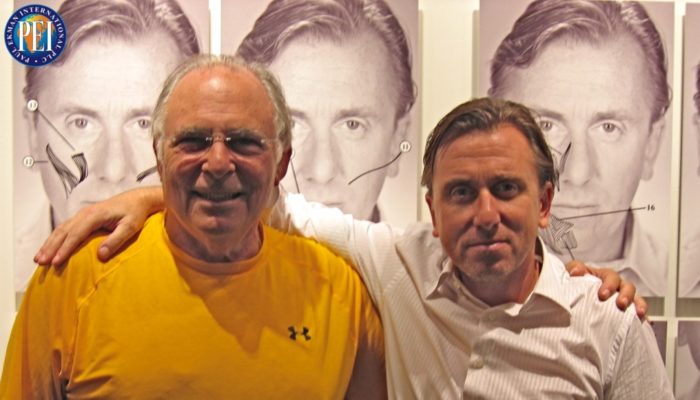

To go such details, Daniel GOLEMAN first speaks to us about the basic emotions: These are the simple or primary emotions. Like the primary colors, which define the base of the colors made from them, the basic emotions are the base of our emotions.
To deepen the meaning described by Daniel GOLEMAN, these simple emotions are emotions expressed by the face. Other psychologists have thus carried out their studies to analyze these emotions: They are expressed by the face of the human being, as well as by universal gestures. All of these simple emotions are universally recognized and recognizable.

Paul ECKMAN, American psychologist and Professor of Psychology at the University of Medical Sciences in California, first defined 6 basic emotions:
Surprise, Sadness, Fear, Anger, Disgust, Joy.


Paul EKMAN studied emotions in their relationship to facial expressions.
He is one of the hundred most eminent psychologists of the 20th century.
His life and one of his works have inspired the “Lie to Me” series.

FAMILY OF “SURPRISE” EMOTIONS
According to Daniel GOLEMAN, this family of emotions includes “shock”, “bewilderment”, “amazement”, “astonishment”.
This family of emotions causes eyebrows to rise. This widens the field of vision, and increases the amount of light reaching the retina. The individual can pick up additional information about an unexpected event. This allows him to better assess the situation and design a better plan of action.

FAMILY OF “SADNESS” EMOTIONS
According to Daniel GOLEMAN, this family of emotions includes “sorrow”, “affliction”, “gloom”, “melancholy”, “self-pity”, “loneliness”. It also encompasses “dejection”, “despair”, and when it becomes pathological, “deep depression”.
One of the main functions of sadness is to help cope with a painful loss. This loss can be that of a loved one, for example, or a great disappointment. Thus, sadness causes a drop in energy and a lack of enthusiasm for the pursuits of life. It is accompanied by a decrease in distractions and pleasures. And when it gets deeper, it approaches depression, and we see a slowing down in metabolism. So, thanks to this analysis, we understand that turning in on oneself makes it possible to mourn a loved one or to digest a fallen hope. Also, it allows you to measure the consequences on your own life. When the energy returns, we can then project a new beginning.

“FEAR” EMOTIONS FAMILY
According to Daniel GOLEMAN, this family of emotions includes “anxiety”, “apprehension”, “nervousness”, “worry”, “consternation”, “fear”. It also encompasses “caution”, “irritation”, “dread”, “terror”, “dread”, and, as pathologies, “phobia” and “panic”.
As Daniel GOLEMAN reports, fear directs the blood to the muscles, those which control the movement of the body, such as the muscles of the legs: These prepare flight and cause the face to turn pale, the blood being driven out. The body is paralyzed for a moment, giving the individual time to decide whether to hide, run, or attack. The brain’s emotional centers massively secrete hormones that put the body on high alert.

FAMILY OF “ANGER” EMOTIONS
According to Daniel GOLEMAN, this family of emotions includes in particular “fury”, “indignation”, “resentment”, “wrath”, “exasperation”, “hassle”. It also encompasses “acrimony”, “animosity”, “discontent”, “irritability”, “hostility”, and, perhaps in the extreme, “hate” and “pathological violence”. .
Anger causes blood to rush to the hands, allowing the individual to more quickly grab a weapon, or strike an enemy, and a massive secretion of hormones, such as adrenaline, releases the energy needed for vigorous action.

FAMILY OF “DISGUET” EMOTIONS
According to Daniel GOLEMAN, this family of emotions includes “contempt”, “disdain”, “repulsion”, “aversion”, “repugnance”, “disgust”.
All over the world, disgust is manifested by the same expression and has the same meaning: Something that is unpleasant. As DARWIN pointed out, the facial expression of disgust seems to reflect a primitive attempt to close the nostrils, at an unpleasant odor, or spit out a poisonous food.

“JOY” EMOTIONS FAMILY
According to Daniel GOLEMAN, this family of emotions includes “pleasure”, “happiness”, “relief”, “contentment”, “bliss”, “delight”. It equally encompasses “fun”, “pride”, “thrill (thrill of joy)”, “delight”, “satisfaction”, “euphoria”, “fantasy mood”, “the ‘ecstasy’, and in the extreme, ‘mania’.
Joy and happiness are characterized by an increase in the activity of the cerebral center which inhibits negative feelings. They favor the increase of the available energy. They slow down the activity of the centers that generate anxiety.
This state provides the body with general rest.
The individual accomplishes with eagerness and enthusiasm the tasks presented to him.
He has more varied goals.

MULTIPLE EMOTIONS, FORMED FROM BASIC EMOTIONS
As we introduced with the work of Paul ECKMAN, we talked about the 6 basic emotions, because the other emotions are combinations of several basic emotions.
Thus indignation can be defined as a mixture of anger and disgust.

ADDITIONAL DISCOVERIES IN TERMS OF EMOTIONAL INTELLIGENCE
A few years later, Paul ECKMAN, published new analyzes around emotional intelligence, defining the possibility of the existence of more than 6 basic emotions. Daniel CORDARO & Dacher KELTNER, two former students of Paul ECKMAN, defined a larger list of universal emotions: They thus added the emotions of:
Boredom, confusion, interest, pride, shame, contempt, relief and triumph,
which have recognizable facial expressions; as well as:
Amusement, fear, contentment, desire, embarrassment, pain, relief, sympathy,
which have particular facial and vocal expressions.

EMOTIONS AND COGNITIVE PSYCHOLOGY
We share with you the cognitive psychology course, by Michel DENIS, in relation to emotions. Michel DENIS is a French psychologist, researcher at the CNRS (Emeritus Research Director then Honorary Research Director).
Cognitive Psychology – Emotions
